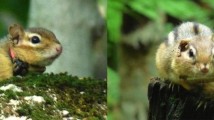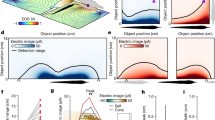Abstract
Birds are frequently vocal. Monitoring their songs and calls has provided much useful information about their ecology and behavior. Recording bird songs and locations can be resource intensive, frequently requiring two or more observers, causing considerable disturbance and possible only for short times. Passive arrays of acoustic sensors offer the possibility of greatly increasing our ability to monitor bird activity. The desirability of such arrays is obvious: they are less intrusive, can monitor continuously over long periods, permit collaboration which enables better localization, provide fault tolerance, and facilitate sharing to optimize scarce resources. That the interest has been increasing so much lately is in large part, because we are now at the point, where the promise of such arrays is realizable with current or reasonably anticipated technologies. Controlling collaborative arrays can be difficult. Engineered solutions are sometimes available, but they are often brittle and appropriate only for ideal environments. We would like our systems to be: robust, in that they can handle changing environments or agents and are untroubled by occasionally wrong or noisy messages; adaptive in that they can learn to deal with unanticipated source or events, form new concepts, and communicate in languages that are specialized for particular agents; and finally, they should be self-configuring, to deal with changing situations and goals. After reviewing research employing sensor arrays by others to monitor bird behavior, we will describe research in our laboratory. Our focus will be on the construction of such systems, especially how such arrays can extract information from the environment and communicate to arrive at a collective understanding of their region and events occurring there.




Similar content being viewed by others
Explore related subjects
Discover the latest articles, news and stories from top researchers in related subjects.References
Estrin D, Michener W, Bonito G (2003) Environmental infrastructure needs for distributed sensor networks: a report from a national science foundation workshop, 12–14 august, 2003, Scripps Institute of Oceanography
Porter JH, Nagy E, Kratz TK, Hanson P, Collins SL, Arzberger P (2009) New eyes on the world: advanced sensors for ecology. BioScience 59(5):385–397
Blumstein DT, Mennill DJ, Clemins P, Girod L, Yao K, Patricelli G, Deppe JL, Krakauer AH, Clark C, Cortopassi KA, Hanser SF, McCowan B, Ali AM, Kirschel ANG (2011) Acoustic monitoring in terrestrial environments using microphone arrays: applications, technological considerations and prospectus. J Appl Ecol 48:758–767
Gage S (2015) Remote environmental assessment laboratory. http://www.real.msu.edu/, June 2015. Accessed 2015 June 03
Pijanowski BC, Farina A, Gage SH, Dumyahn SL, Krause BL (2011) What is soundscape ecology? an introduction and overview of an emerging new science. Landsc Ecol 26:1213–1232
Digby A, Towsey M, Bell BD, Teal PD (2013) A practical comparison of manual and autonomous methods for acoustic monitoring. Methods Ecol Evol 4:675–683
Hobson KA, Rempel RS, Greenzuood H, Bull B, Van Wilgenburg SL (2002) Acoustic surveys of birds using electronic recordings: new potential from an omnidirectional microphone system. Wildl Soc Bull 30:709–720
Mennill DJ, Burt JM, Fristrup KM, Vehrencamp SL (2006) Accuracy of an acoustic location system for monitoring the position of duetting songbirds in tropical forest. J Acoust Soc Am 119(5):2832–2839
Mennill DJ, Battiston M, Wilson DR, Foote JR, Doucet SM (2012) Field test of an affordable, portable, wireless microphone array for spatial monitoring of animal ecology and behavior. Methods Ecol Evol 3(4):704–712
Kirschel ANG, Cody ML, Harlow Z, Promponas VJ, Vallejo EE, Taylor CE (2011) Territorial dynamics of mexican antthrushes revealed by individual recognition of their songs. Ibis 153:255–268
Harlow Z (2013) Complex singing behavior of the White-breasted Wood Wren (Henicorhina leucosticta). PhD thesis, Department of Ecology and Evolutionary Biology, University of California, Los Angeles
Collier TC (2010) Wireless sensor network-based acoustic localization for studying animal communication in terrestrial environments. PhD thesis, Department of Ecology and Evolutionary Biology, University of California, Los Angeles
Pottie GJ, Kaiser WJ (2000) Wireless integrated network sensors. Commun ACM 43(5):51–58
Ali AM, Asgari S, Collier TC, Allen M, Girod L, Hudson RE, Yao K, Taylor CE, Blumstein DT (2009) An empirical study of collaborative acoustic source localization. J Signal Process Syst 57:415–436
Kershenbaum A et al (2014) Acoustic sequences in non-human animals: a tutorial review and prospectus. Biol Rev 91:13–52
Collier TC, Kirschel ANG, Taylor CE (2010) Acoustic localization of antbirds in a mexican rainforest using a wireless sensor network. J Acoust Soc Am 128:182–189
Collier TC, Blumstein DT, Girod L, Taylor CE (2010) Is alarm calling risky? marmots avoid calling from risky places. Ethology 116:1–8
Collier T (2015) Voxnet: a deployable bioacoustic sensor network. https://grassi2.ucdavis.edu/~travc/voxnet/Hardware/
Wang N-C, Hudson RE, Tan LN, Taylor CE, Alwan A, Yao K (2013) Bird phrase segmentation by entropy-driven change point detection. In: The 38th international conference on acoustics, speech, and signal processing (ICASSP), Vancouver, Canada, May 16–31, 2013
Kantapon K, Tan LN, Alwan A, Taylor CE (2015) A robust automatic phrase classifier using dynamic time-warping with prominent region identification, pp 1–5
Harlow Z, Collier T, Burkholder V, Taylor CE (2013) IEEE China summit and international conference on signal and information processing (ChinaSIP), Beijing, July, 6–10, 2013. In: Acoustic 3D localization of a tropical song bird
Lee J-Y, Hudson RE, Yao K (2014) Acoustic DOA estimation: an approximate maximum likelihood approach. IEEE Syst J 13–141:1069–1080
Ali A, Hudson R, Yao K (2014) Tracking of acoustic sources using random set theory. IEEE Syst J 8:151–159
Chen JC, Yao K (2005) Beamforming. In: Iyengar SS, Brooks R (eds) Frontiers in distributed sensor networks, vol 12, pp 1067–1105
Chen JC, Hudson RE, Yao K (2002) Maximum-likelihood source localization and unknown sensor location estimation for wideband signals in the near-field. IEEE Trans Signal Process 50:1843–1854
Scott Brandes T (2008) Automated sound recording and analysis techniques for bird surveys and conservation. Bird Conserv Int 18:S163–S173
Tan LN, Alwan A, Kossan G, Cody M, Taylor CE (2015) Dynamic time warping and sparse representation classification for birdsong phrase classification using limited training data. J Acoust Soc Am 137:1069–1080
Arriaga JG, Sanchez H, Hedley R, Vallejo EE, Taylor CE (2014) Using song to identify cassin+s vireo individuals. a comparative study of pattern recognition algorithms. Pattern Recognit pp 291–300
Yao Y (2008) Studies of vocal communications in cooperatively breeding acorn woodpeckers (melanerpes formicivorus). PhD thesis, Department of Ecology and Evolutionary Biology, University of California, Los Angeles
Arriaga J, Cody ML, Vallejo EE, Taylor CE (2014) Bird-db database for annotated bird song sequences. http://taylor0.biology.ucla.edu/birdDBQuery/. Accessed 2014 Aug 07
National Science Foundation (2014) Finalizing an integrated behavior ontology for the behavioral science community. http://grantome.com/grant/NSF/IOS-1439561#panel-abstract
Wee K, Collier T, Kobele G, Stabler EP, Taylor C (2001) Natural language interface to an intrusion detection system. In: International conference on control, automation and systems, ICASE’01. http://taylor0.biology.ucla.edu/al/
Acknowledgments
This work was supported in part by the National Science Foundation Award No. 0410438.
Author information
Authors and Affiliations
Corresponding author
Additional information
This work was presented in part at the 1st International Symposium on Swam Behavior and Bio-inspired Robotics, Kyoto, Japan, October 28–30, 2015.
About this article
Cite this article
Taylor, C.E., Huang, Y. & Yao, K. Distributed sensor swarms for monitoring bird behavior: an integrated system using wildlife acoustics recorders. Artif Life Robotics 21, 268–273 (2016). https://doi.org/10.1007/s10015-016-0295-4
Received:
Accepted:
Published:
Issue Date:
DOI: https://doi.org/10.1007/s10015-016-0295-4




